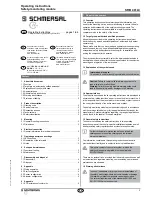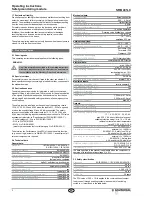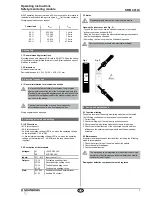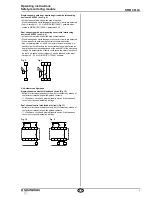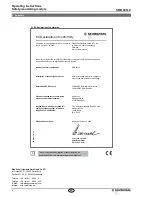
3
SRB 401LC
Operating instructions
Safety-monitoring module
EN
At 365 operating days per year and a 24-hours operation, this results in
the below-mentioned switching cycle times (t
cycle
) for the relay contacts
Diverging applications upon request
Contact load
n
op/y
t
cycle
20 %
525,600
10 min
40 %
210,240
25 min
60 %
75,087
70 min
80 %
30,918
170 min
100 %
12,223
430 min
3. Mounting
3.1 General mounting instructions
Mounting: snaps onto standard DIN rails to EN 60715 Snap the bottom
of the enclosure slightly tilted forwards in the DIN rail and push up until
it latches in position
3.2 Dimensions
All measurements in mm
Device dimensions (H × W × D): 100 × 22,5 × 121 mm
4. Electrical connection
4.1 General information for electrical connection
As far as the electrical safety is concerned, the protection
against unintentional contact of the connected and therefore
electrically interconnected apparatus and the insulation of the
feed cables must be designed for the highest voltage, which
can occur in the device
The electrical connection may only be carried out by
authorised personnel in a de-energised condition
Wiring examples: see appendix
5. Operating principle and settings
5.1 LED functions
• K1: Status channel 1
• K2: Status channel 2
• U
B
: Status operating voltage (LED is on, when the operating voltage
on the terminals A1 - A2 is ON)
• U
i
: Status internal operating voltage (LED is on, when the operating
voltage on the terminals A1 - A2 is ON and the fuse has not been
triggered)
5.2 Description of the terminals
Voltages:
A1
A2
+24 VDC/24 VAC
0 VDC/24 VAC
Inputs:
S11 - S12
Input channel 1 (+)
Outputs:
13-14
23-24
33-34
43-44
First safety enabling circuit
Second safety enabling circuit
Third safety enabling circuit
Fourth safety enabling circuit
Start:
S33-S34
51-52
Feedback circuit and external reset
Auxiliary NC contact
5.3 Notes
Signalling outputs must not be used in safety circuits
Opening the front cover (see Fig. 2)
• To open the front cover, insert a slotted screwdriver in the top and
bottom cover notch and gently lift it
• When the front cover is open, the electrostatic discharge requirements
must be respected and observed
• After setting, the front cover must be fitted back in position
Only touch the components after electrical discharge!
Fig. 1
Fig. 2
U
B
U
i
K1
K2
SRB
401LC
A1 S34S33 S11
S12 51 52 A2
43 44 13 14
33 34 23 24
U
B
U
i
K1
K2
SRB
031MA
S11 17 27 37
S12 18 28 38
S21 46 X2 A2
S22 45 X1 A1
U
B
U
i
K1
K2
SRB
031MA
S11 17 27 37
S12 18 28 38
S21 46 X2 A2
S22 45 X1 A1
6. Set-up and maintenance
6.1 Functional testing
The safety function of the safety-monitoring module must be tested
The following conditions must be previously checked and met:
1 Correct fixing
2 Check the integrity of the cable entry and connections
3 Check the safety-monitoring module's enclosure for damage
4 Check the electrical function of the connected sensors and their
influence on the safety-monitoring module and the downstream
actuators
6.2 Maintenance
A regular visual inspection and functional test, including the following
steps, is recommended:
1 Check the correct fixing of the safety-monitoring module
2 Check the cable for damages
3 Check electrical function
The device has to be integrated into the periodic check-ups
according to the Ordinance on Industrial Safety and Health,
however at least 1x/year
Damaged or defective components must be replaced.

